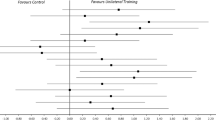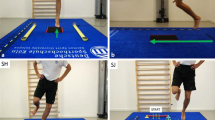Abstract
Purpose
Performing resistance exercises unilaterally, athletes must activate stabilizing muscles to maintain balance position, and for the same relative load, compressive forces on the spine are reduced providing more safety. Our aim was to compare the effects of resistance training when bilateral and unilateral exercises were used.
Methods
Twenty-six young handball players first participated in a 6-week control phase consisting of handball training only, and were later divided into a unilateral and a bilateral group in the experimental phase. Before and after the control and experimental phases, tests of horizontal and vertical jumping, lateral running with change of direction, standing and jump shots with the dominant and nondominant arms were performed.
Results
Simultaneous performance of handball and resistance training resulted in greater progress in power and agility compared to handball training alone. The average progress of the unilateral group was greater on all measured variables. However, the differences reached statistical significance only in triple jump and throwing with the non-dominant arm (p < 0.05).
Conclusion
Young handball players achieved similar or greater power and agility with unilateral resistance exercises than with bilateral resistance exercises. Considering the benefits unilateral resistance exercises bring, this type of training is highly recommended.



Similar content being viewed by others
References
Suchomel TJ, Nimphius S, Stone MH (2016) The importance of muscular strength in athletic performance. Sport Med 46:1419–1449
Haff G, Triplett NT (2016) Essentials of strength training and conditioning, 4th edn. Human Kinetics, Champaign
Lloyd RS, Oliver JL (2012) The youth physical development model: a new approach to long-term athletic development. Strength Cond J 34:61–72
Gamble P (2008) Approaching physical preparation for youth team-sports players. Strength Cond J 30:29–42
Behm DG, Young JD, Whitten JHD, Reid JC, Quigley PJ, Low J et al (2017) Effectiveness of traditional strength vs. power training on muscle strength, power and speed with youth: a systematic review and meta-analysis. Front Physiol 8:423
Faigenbaum AD, Myer GD (2010) Pediatric resistance training: benefits, concerns, and program design considerations. Curr Sports Med Rep 9:161–168
Gorostiaga EM, Izquierdo M, Iturralde P, Ruesta M, Ibáñez J (1999) Effects of heavy resistance training on maximal and explosive force production, endurance and serum hormones in adolescent handball players. Eur J Appl Physiol Occup Physiol 80:485–493
Bompa TO, Haff G (2009) Periodization: theory and methodology of training. Human Kinetics, Champaign
Gonzalo-Skok O, Tous-Fajardo J, Suarez-Arrones L, Arjol-Serrano JL, Casajús JA, Mendez-Villanueva A (2017) Single-leg power output and between-limbs imbalances in team-sport players: unilateral versus bilateral combined resistance training. Int J Sports Physiol Perform 12:106–114
McCurdy K, Conner C (2003) Unilateral Support Resistance Training Incorporating the Hip and Knee. Strength Cond J 25:45–51
McCurdy KW, Langford GA, Doscher MW, Wiley LP, Mallard KG (2005) The effects of short-term unilateral and bilateral lower-body resistance training on measures of strength and power. J Strength Cond Res 19:9–15. https://doi.org/10.1519/14173.1
Jansson D (2013) Effects of unilateral versus bilateral complex training and high intensity interval training on the development of strength, power and athletic performance - an experimental study on elite male and female handball players during preseason training, the swedish school of sport and health sciences.***
Drouzas V, Katsikas C, Zafeiridis A, Jamurtas AZ, Bogdanis GC (2020) Unilateral plyometric training is superior to volume-matched bilateral training for improving strength, speed and power of lower limbs in preadolescent soccer athletes. J Hum Kinet 74:161–176
Wagner H, Fuchs PX, von Duvillard SP (2018) Specific physiological and biomechanical performance in elite, sub-elite and in non-elite male team handball players. J Sports Med Phys Fit 58:73–81. https://doi.org/10.23736/S0022-4707.16.06758-X
Taylor JB, Wright AA, Dischiavi SL, Townsend MA, Marmon AR (2017) Activity demands during multi-directional team sports: a systematic review. Sports Med 47:2533–2551
Izquierdo M, Häkkinen K, Gonzalez-Badillo JJ, Ibáñez J, Gorostiaga EM (2002) Effects of long-term training specificity on maximal strength and power of the upper and lower extremities in athletes from different sports. Eur J Appl Physiol 87:264–271
Stern D, Gonzalo-Skok O, Loturco I, Turner A, Bishop C (2020) A Comparison of bilateral vs. unilateral-biased strength and power training interventions on measures of physical performance in elite youth soccer players. J Strength Cond Res 34:2105–2111
Hermassi S, Haddad M, Bouhafs EG, Laudner KG, Schwesig R (2019) Comparison of a combined strength and handball-specific training vs. isolated strength training in handball players studying physical education. Sportverletzung-Sportschaden 33:149–159
Fisher J, Wallin M (2014) Unilateral versus bilateral lower-body resistance and plyometric training for change of direction speed. J Athl Enhanc 3:06. https://doi.org/10.4172/2324-9080.1000174
Ramirez-Campillo R, Sanchez-Sanchez J, Gonzalo-Skok O, Rodríguez-Fernandez A, Carretero M, Nakamura FY (2018) Specific changes in young soccer player’s fitness after traditional bilateral vs. unilateral combined strength and plyometric training. Front Physiol 9:265
Lockie RG, Callaghan SJ, Berry SP, Cooke ERA, Jordan CA, Luczo TM et al (2014) Relationship between unilateral jumping ability and asymmetry on multidirectional speed in team-sport athletes. J Strength Cond Res 28:3557–3566
Hay JG (1992) The biomechanics of the triple jump: a review. J Sports Sci 1:343–378
Hermassi S, Delank KS, Fieseler G, Bartels T, Chelly MS, Khalifa R et al (2019) Relationships between olympic weightlifting exercises, peak power of the upper and lower limb, muscle volume and throwing ball velocity in elite male handball players. Sportverletzung-Sportschaden 33:104–112
Hermassi S, Chelly MS, Tabka Z, Shephard RJ, Chamari K (2011) Effects of 8 week in-season upper and lower limb heavy resistance training on the peak power, throwing velocity, and sprint performance of elite male handball players. J Strength Cond Res 25:2424–2433
Markovic G (2007) Does plyometric training improve vertical jump height? A meta-analytical review. Br J Sports Med 41:349–355
Yanci J, Arcos AL, Camara J, Castillo D, García A, Castagna C et al (2016) Effects of horizontal plyometric training volume on soccer players’ performance. Res Sport Med 24:308–319
Menzel H-J, Chagas MH, Szmuchrowski LA, Araujo SRS, de Andrade AGP, de Jesus-Moraleida FR (2013) Analysis of lower limb asymmetries by isokinetic and vertical jump tests in soccer players. J Strength Cond Res 27:1370–1377
Helme M, Tee J, Emmonds S, Low C (2021) Does lower-limb asymmetry increase injury risk in sport? A systematic review. Phys Ther Sport 49:204–213
Fett D, Trompeter K, Platen P (2017) Back pain in elite sports : a cross-sectional study on 1114 athletes. PLoS ONE 12:e0180130
Funding
No financial or material support of any kind was received for the work described in this article. All authors read and approved the final version of the manuscript.
Author information
Authors and Affiliations
Corresponding author
Ethics declarations
Conflict of interest
The authors certify that there is no conflict of interest with any financial organization regarding the material discussed in the manuscript.
Ethical approval
All procedures performed in the study involving young athletes were in accordance with the ethical standards of the institutional (University of Ljubljana) research commite and with the 164 Helsinki declarations and its later amendments or comparable standards.
Informed consent
Informed consent was obtained from the participants and their legal guardians.
Additional information
Publisher's Note
Springer Nature remains neutral with regard to jurisdictional claims in published maps and institutional affiliations.
Rights and permissions
About this article
Cite this article
Pori, P., Martinc, D., Šibila, M. et al. The comparison of the unilateral and bilateral resistance training in young handball players. Sport Sci Health 19, 691–700 (2023). https://doi.org/10.1007/s11332-022-00950-z
Received:
Accepted:
Published:
Issue Date:
DOI: https://doi.org/10.1007/s11332-022-00950-z




